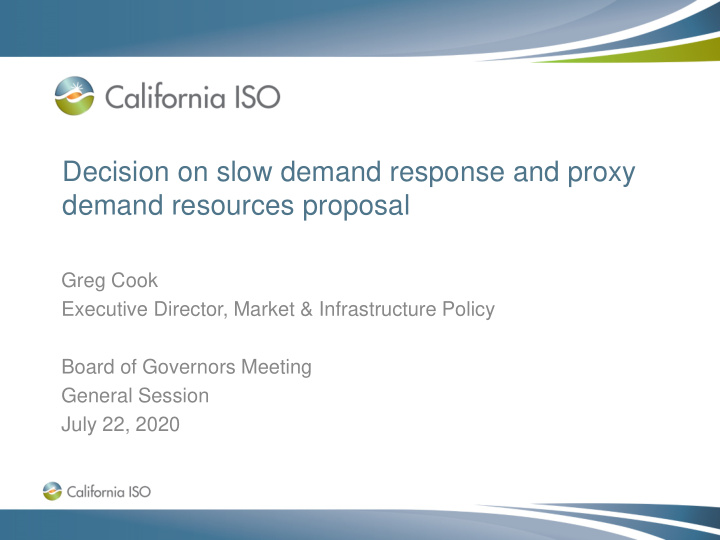



Decision on slow demand response and proxy demand resources proposal Greg Cook Executive Director, Market & Infrastructure Policy Board of Governors Meeting General Session July 22, 2020
Tariff revisions are necessary to operationalize slow demand response resources for local needs • To meet local RA needs, resources must either: – Be able to respond within 20 minutes following a contingency event, or – Have availability to be dispatched frequently on a pre-contingency basis • In 2016, proposed BPM revision would require resource availability within 20 minutes to qualify as local RA – Impacted demand response resources without the flexibility or capability to respond within 20 minute notification – Appeal made by multiple demand response stakeholders was granted by the ISO executive appeals committee Page 2
Management developed a methodology to pre-contingency dispatch slow DR resources. • New process for pre-contingency dispatch developed through CPUC and ISO stakeholder processes – CPUC DR supply-side working group, resource adequacy enhancements, and proxy demand resource RA clarifications initiatives – Settlement of pre-contingency dispatch requires new tariff provision and board approval • CPUC counts slow demand response resources as local RA • Management agreed not to procure backstop for local RA deficiencies related to slow demand response until a solution was implemented Page 3
Pre-contingency dispatch solution for slow demand response leverages minimum online commitment tool Pre-Day- Ahead Market CAISO Defines Day-Ahead MOCs in local areas Market DAM runs with MOCs (excluding Post-DAM/Prior to slow DR in the Operating Day the MOC) If MOC infeasible, exceptionally dispatch slow Operating Day DR Slow DR drops load during hours of ED Page 4
Tariff changes are needed to enable the slow demand response pre-contingency exceptional dispatch solution. • Current tariff authority is limited to real-time energy settlement of exceptional dispatches • Management proposes new methodology for energy settlement of exceptional dispatch of slow demand response prior to the operating day – Energy settled at the maximum of the resources day-ahead bid price or applicable real-time locational marginal price Page 5
The pre-contingency dispatch solution will apply starting with the 2021 resource adequacy compliance year • CPUC “credits” utility demand response programs as resource adequacy and does not require them to be shown on resource adequacy plans – Crediting means demand response not subject to ISO RA tariff provisions like all other RA resources – Solution can only operationalize demand response resources shown on supply plans – After a cure period, the ISO will procure additional resources through its backstop authority if there are insufficient resources shown on RA supply plans to meet local area capacity needs Page 6
Stakeholder support is dependent on the impact this solution has on the CPUC’s DR RA crediting practice • No stakeholders commented on the initiatives proposed settlement of pre-contingency dispatch • Stakeholders generally supportive of the pre-contingency dispatch solution including supply plan submission requirement – DMM commented on broader concerns about the cumulative effect of energy-limited or availability-limited resources relied upon to meet resource adequacy requirements • SCE, SDG&E, and PG&E oppose showing of demand response programs on supply plans Page 7
Management recommends the Board approve the proposed settlement provisions for pre-contingency exceptional dispatch of slow demand response. • Provides new provisions to settle exceptional dispatches of slow demand response at the higher of the day-ahead market bid price and the real time fifteen minute locational marginal price • Allows slow demand response to be dispatched and settled on a pre-contingency basis for local RA qualification – in compliance with NERC standards • Satisfies the 2016 BPM appeals committee decision deferring implementation of PRR 854 Page 8
Recommend
More recommend